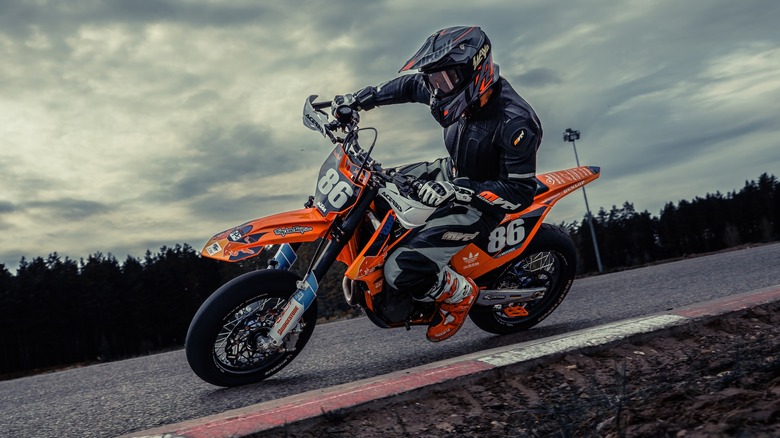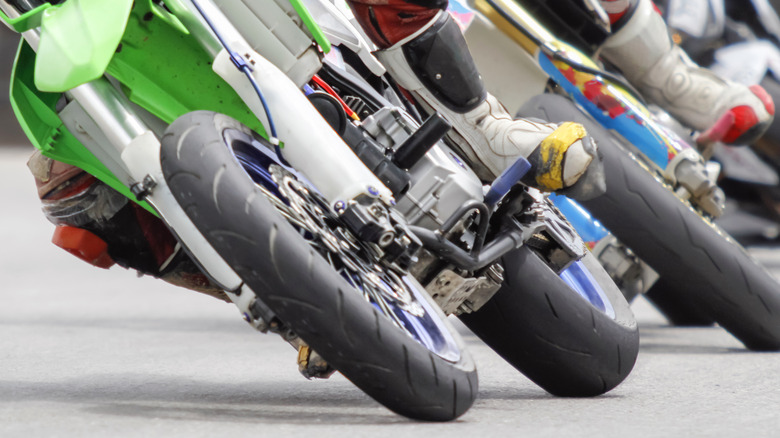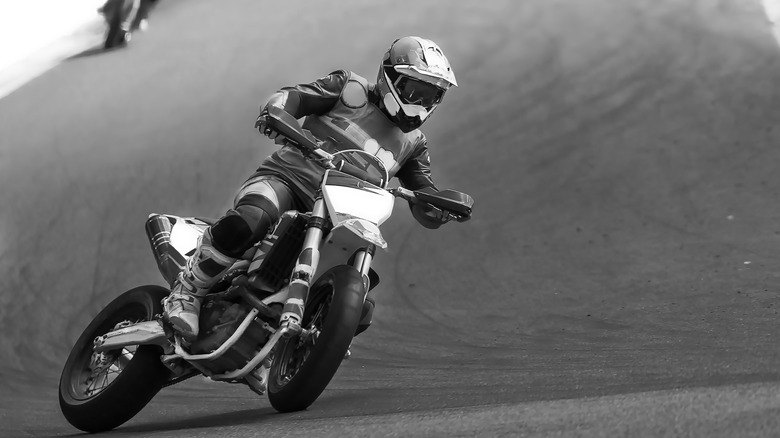
OlegRi/Shutterstock
By Brad Hill/
It’s an oversimplification to say that supermoto and dirt bikes use different tires because that’s just the tip of the iceberg. They might appear nearly identical, but there are some significant, albeit subtle, differences that the uninitiated won’t notice in the same way that enduro bikes are different than other motorcycles. It’s more apt to say that supermoto bikes are modified dirt bikes because they’re not only outfitted with different tires, but the wheel and rim sizes are smaller along with a modified suspension and a larger front brake. Why all the changes?
Dirt bike racing takes place on tracks made of, well, dirt, which includes a lot of uphill and downhill riding and bouncing around. Supermoto races, on the other hand, happen primarily on an asphalt track. There are dirt sections, but it roughly makes up only 20% of the track. This style of racing came from the mind of British motorcycle racing promotor, journalist, and publisher Gavin Trippe. He worked with ABC in the ’70s to create «Superbikers,» a TV series about motorcycle racing that blended flat track, motocross, and road racing together as a means to find the best all-around racer.
«Superbikers» had a significant influence on the world of motorcycle racing, and eventually gave birth to the Supermoto bike as the world knows it. So, exactly what sets supermoto motorcycles apart from others?
The modifications that make a supermoto motorcycle

Toa55/Shutterstock
While larger wheels are great for going over bumps and other obstacles typically encountered on MX tracks, smaller wheels are ideal for turning. To combat those tight turns on a supermoto track, supermoto bikes use 17-inch wheels for the front and rear, with the front typically being 3.5-inches wide and the rear slightly wider at 5 inches. In contrast, their dirt bike cousins generally have a 21-inch front wheel and a 19-inch rear wheel.
Since Supermoto racing also consists of some jumps, long straightaways and, more importantly, a flat paved tarmac track, the tires need a completely different tread. Just as the tires on a typical cruiser aren’t all knobbly like that of an off-road bike, neither are the ones used in supermoto. While that knobby tread helps with getting through dirt or mud, it’s not going to be as beneficial on a paved surface, which supermoto bikes spend the majority of their time on. Supermoto racing calls for smooth and slick tires because they do a better job at gripping asphalt.
While they aren’t the fastest motorcycles ever built, supermoto bikes travel at high speeds, which means they need brakes that can handle the velocity. That’s why they utilize oversized rotors and calipers in their brake setup. Additionally, supermoto bikes don’t have to concern themselves with as many obstacles in their path, since the suspension is tighter and the bike is given a lower profile to help with the demanding turns of a supermoto track.
Supermoto motorcycles are versatile

Ondrej_Novotny_92/Shutterstock
When Gavin Trippe created «Superbikers,» he might have been looking for the best well-rounded racer the world had to offer, but it also meant finding a motorcycle that could do it all. The diversity of a supermoto track, changing up the terrain the way it did, essentially created incredibly versatile machines. These are motorcycles that can go from speeding across the tarmac to rounding a dirt-made berm, and landing a jump with little struggle.
Not only are they versatile, but they’re also tough motorcycles. If one takes a tumble, as commonly happens in motorcycle racing, the bill won’t be so astronomical that the racer can’t afford their rent next month. Compared to the repair costs of a sports bike, it’s relatively painless, so to speak. Supermoto motorcycles can take a beating. At worst, you might end up with a bent clutch lever. There might be some sleek sports bikes that will tempt riders to trade in their cruiser, but a supermoto motorcycle can be a fun ride at the track.